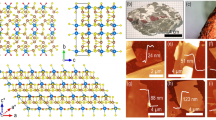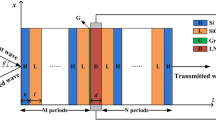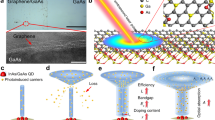Abstract
Due to the unique anisotropic chemical and physical properties, two-dimensional (2D) layered materials, such as IV-VI monochalcogenides with puckered honeycomb structure, have received considerable interest recently. Among the IV-VI layered MX (M = Ge, Sn; X = Se, S) compounds, germanium sulfide (GeS) stands out for its strongest anisotropic thermal conductivities and figure-of-merit values. Additionally, the layer-independent direct energy bands (Eg ∼1.6 eV, E1 ∼2.1 eV) of GeS flake provide excellent insights into further applications as visible photodetectors. Herein, the polarization-tunable nonlinear absorption (NA) patterns of GeS flake have been systematically investigated. Specifically, both the polarization-dependent Raman spectroscopy and the linear absorption (LA) spectroscopy were employed to characterize the lattice orientation and absorption edges of the 251-nm GeS flake. Considering the low damage threshold of GeS flake, the GeS/graphene heterostructure was fabricated to increase the threshold without changing the nonlinear properties of GeS. Our NA results demonstrated that a 600-nm femtosecond laser with different polarizations would excite the saturated-absorption (SA) effect along armchair and reverse-saturated-absorption (RSA) effect along zigzag in the GeS/graphene heterostructure. Moreover, the function of the polarization-based GeS/graphene heterostructure all-optical switch was experimentally verified. Notably, thanks to the polarization-dependent NA patterns (SA/RSA) of GeS, the “ON” and “OFF” states of the all-optical switch can be accomplished by high and low transmittance states of continuous-wave laser (532 nm, 80 nW), whose state can be controlled by the polarization of femtosecond switching laser (600 nm, 35 fs, 500 Hz, 12 GW cm−2). The ON/OFF ratio can achieve up to 17% by changing polarization, compared with the ratios of 3.0% by increasing the incident power of switching light in our experiment. The polarization-tunable absorption patterns introduced in this work open up real perspectives for the next-generation optoelectronic devices based on GeS/graphene heterostructure.
摘要
近年来, 一些二维层状材料, 尤其是具有褶皱蜂窝结构的IVVI 族单硫化物, 由于其特殊的各向异性化学和物理性质, 而备受关 注. 在IV-VI族层状化合物MX (M=Ge, Sn; X=Se, S)中, 硫化锗(GeS) 以其最强的各向异性热导率和热电品质因子而引人注目. 此外, GeS薄片与层数无关的直接能带(Eg∼1.6 eV, E1∼.1 eV)为可见光光 探测器的应用提供了良好的应用前景. 本文研究了GeS薄片的偏振 可调非线性吸收模式, 利用偏振相关拉曼光谱和线性吸收光谱表 征了厚度为251 nm GeS的晶格取向和吸收能带. 考虑到GeS薄片的 较低的热损伤阈值, 在不改变GeS非线性特性的前提下, 制备了硫 化锗/石墨烯异质结. 非线性吸收结果表明, 在硫化锗/石墨烯异质 结中, 利用偏振可调的600 nm线偏振飞秒激光沿扶手椅方向激发 产生饱和吸收(SA)效应, 沿锯齿方向激发反饱和吸收(RSA)效应. 实验验证了基于偏振的硫化锗/石墨烯异质结全光开关的功能. 值 得注意的是, 正因为GeS的偏振相关非线性吸收模式(SA/RSA), 全 光开关的“开”、“关”状态可通过控制飞秒开关激光(600 nm, 35 fs, 500 Hz, 12 GW cm−2)的偏振, 进而改变连续光(CW)激光(532 nm, 80 nW)透射率的方式来实现. 通过改变开关光的偏振, 开关比可以 达到17%, 与之相比, 通过提高开关光入射功率获得的开关比仅为 3.0%. 本文介绍的偏振可调吸收模式, 为基于硫化锗/石墨烯异质结 的下一代光电子器件开辟了新的前景.
Similar content being viewed by others
References
Novoselov KS, Geim AK, Morozov SV, et al. Electric field effect in atomically thin carbon films. Science, 2004, 306: 666–669
Novoselov KS, Geim AK, Morozov SV, et al. Two-dimensional GaS of massless Dirac fermions in graphene. Nature, 2005, 438: 197–200
Jiang T, Huang D, Cheng J, et al. Gate-tunable third-order nonlinear optical response of massless Dirac fermions in graphene. Nat Photon, 2005, 12: 430–436
Zhang J, Ouyang H, Zheng X, et al. Ultrafast saturable absorption of MoS2 nanosheets under different pulse-width excitation conditions. Opt Lett, 2018, 43: 243–246
Yang X, Li Q, Hu G, et al. Controlled synthesis of high-quality crystals of monolayer MoS2 for nanoelectronic device application. Sci China Mater, 2016, 59: 182–190
Zhang S, Dong N, McEvoy N, et al. Direct observation of degenerate two-photon absorption and its saturation in WS2 and MoS2 monolayer and few-layer films. ACS Nano, 2015, 9: 7142–7150
Zheng C, Xu ZQ, Zhang Q, et al. Profound effect of substrate hydroxylation and hydration on electronic and optical properties of monolayer MoS2. Nano Lett, 2015, 15: 3096–3102
Saynatjoki A, Karvonen L, Rostami H, et al. Ultra-strong nonlinear optical processes and trigonal warping in MoS2 layers. Nat Commun, 2017, 8: 893
Hong S, Fu D, Hou J, et al. Robust photoluminescence energy of MoS2/graphene heterostructure against electron irradiation. Sci China Mater, 2018, 61: 1351–1359
Sobota JA, Yang SL, Kemper AF, et al. Direct optical coupling to an unoccupied Dirac surface state in the topological insulator Bi2 Se3. Phys Rev Lett, 2013, 111: 136802
Zhang H, Liu CX, Qi XL, et al. Topological insulators in Bi2Se3, Bi2Te3 and Sb2Te3 with a single Dirac cone on the surface. Nat Phys, 2013, 5: 438–442
Zhang J, Jiang T, Zhou T, et al. Saturated absorption of different layered Bi2Se3 films in the resonance zone. Photon Res, 2018, 6: C8
Jiang T, Miao RL, Zhao J, et al. Electron-phonon coupling in topological insulator Bi2Se3 thin films with different substrates. Chin Opt Lett, 2019, 17: 020005
Meng X, Zhou Y, Chen K, et al. Anisotropic saturable and excited-state absorption in bulk ReS2. Adv Opt Mater, 2018, 6: 1800137
Li XL, Han WP, Wu JB, et al. Layer-number dependent optical properties of 2D materials and their application for thickness determination. Adv Funct Mater, 2017, 27: 1604468
Guo B, Xiao Q, Wang S, et al. 2D layered materials: Synthesis, nonlinear optical properties, and device applications. Laser Photonics Rev, 2019, 13: 1800327
Jiang T, Yin K, Wang C, et al. Ultrafast fiber lasers mode-locked by two-dimensional materials: Review and prospect. Photon Res, 2020, 8: 78
Guo Z, Zhang H, Lu S, et al. From black phosphorus to phosphorene: Basic solvent exfoliation, evolution of Raman scattering, and applications to ultrafast photonics. Adv Funct Mater, 2015, 25: 6996–7002
Yang T, Abdelwahab I, Lin H, et al. Anisotropic third-order nonlinearity in pristine and lithium hydride intercalated black phosphorus. ACS Photonics, 2018, 5: 4969–4977
Zhou Y, Zhang M, Guo Z, et al. Recent advances in black phosphorus-based photonics, electronics, sensors and energy devices. Mater Horiz, 2017, 4: 997–1019
Liu E, Fu Y, Wang Y, et al. Integrated digital inverters based on two-dimensional anisotropic ReS2 field-effect transistors. Nat Commun, 2015, 6: 6991
Liu F, Zheng S, He X, et al. Highly sensitive detection of polarized light using anisotropic 2D ReS2. Adv Funct Mater, 2016, 26: 1169–1177
Huang S, Tatsumi Y, Ling X, et al. In-plane optical anisotropy of layered gallium telluride. ACS Nano, 2016, 10: 8964–8972
Luo Z, Maassen J, Deng Y, et al. Anisotropic in-plane thermal conductivity observed in few-layer black phosphorus. Nat Commun, 2015, 6: 8572
Youngblood N, Peng R, Nemilentsau A, et al. Layer-tunable third-harmonic generation in multilayer black phosphorus. ACS Photonics, 2016, 4: 8–14
Yang S, Liu Y, Wu M, et al. Highly-anisotropic optical and electrical properties in layered SnSe. Nano Res, 2017, 11: 554–564
Ye Y, Xian Y, Cai J, et al. Linear and nonlinear optical properties of few-layer exfoliated SnSe nanosheets. Adv Opt Mater, 2019, 7: 1800579
Xia F, Wang H, Jia Y. Rediscovering black phosphorus as an anisotropic layered material for optoelectronics and electronics. Nat Commun, 2014, 5: 4458
Li L, Yu Y, Ye GJ, et al. Black phosphorus field-effect transistors. Nat Nanotech, 2014, 9: 372–377
Wei Y, He J, Zhang Q, et al. Synthesis and investigation of layered GeS as a promising large capacity anode with low voltage and high efficiency in full-cell Li-ion batteries. Mater Chem Front, 2017, 1: 1607–1614
Hu X, Huang P, Liu K, et al. Salt-assisted growth of ultrathin GeSe rectangular flakes for phototransistors with ultrahigh responsivity. ACS Appl Mater Interfaces, 2019, 11: 23353–23360
Zhou X, Hu X, Jin B, et al. Highly anisotropic GeSe nanosheets for phototransistors with ultrahigh photoresponsivity. Adv Sci, 2018, 5: 1800478
Wu L, Xie Z, Lu L, et al. Few-layer tin sulfide: A promising black-phosphorus-analogue 2D material with exceptionally large nonlinear optical response, high stability, and applications in all-optical switching and wavelength conversion. Adv Opt Mater, 2018, 6: 1700985
Xu X, Song Q, Wang H, et al. In-plane anisotropies of polarized Raman response and electrical conductivity in layered tin selenide. ACS Appl Mater Interfaces, 2017, 9: 12601–12607
Zhou X, Hu X, Zhou S, et al. Tunneling diode based on WSe2/SnS2 heterostructure incorporating high detectivity and responsivity. Adv Mater, 2018, 30: 1703286
Zhang S, Liu S, Huang S, et al. Structural and electronic properties of atomically thin germanium selenide polymorphs. Sci China Mater, 2015, 58: 929–935
Qin G, Qin Z, Fang WZ, et al. Diverse anisotropy of phonon transport in two-dimensional group IV-VI compounds: A comparative study. Nanoscale, 2016, 8: 11306–11319
Shafique A, Shin YH. Thermoelectric and phonon transport properties of two-dimensional IV-VI compounds. Sci Rep, 2017, 7: 506
Hsueh HC, Li JX, Ho CH. Polarization photoelectric conversion in layered GeS. Adv Opt Mater, 2018, 6: 1701194
Li F, Liu X, Wang Y, et al. Germanium monosulfide monolayer: A novel two-dimensional semiconductor with a high carrier mobility. J Mater Chem C, 2016, 4: 2155–2159
Zhang S, Wang N, Liu S, et al. Two-dimensional GeS with tunable electronic properties via external electric field and strain. Nanotechnology, 2016, 27: 274001
Guo SD, Wang YH. Thermoelectric properties of orthorhombic group IV-VI monolayers from the first-principles calculations. J Appl Phys, 2017, 121: 034302
Ma Z, Wang B, Ou L, et al. Structure and properties of phosphorene-like IV-VI 2D materials. Nanotechnology, 2016, 27: 415203
Li BW, Wang Y, Xie YQ, et al. Strain controlled switching effects in phosphorene and GeS. Nanotechnology, 2017, 28: 435202
Tan D, Lim HE, Wang F, et al. Anisotropic optical and electronic properties of two-dimensional layered germanium sulfide. Nano Res, 2016, 10: 546–555
Ho CH, Li JX. Polarized band-edge emission and dichroic optical behavior in thin multilayer GeS. Adv Opt Mater, 2017, 5: 1600814
Ulaganathan RK, Lu YY, Kuo CJ, et al. High photosensitivity and broad spectral response of multi-layered germanium sulfide transistors. Nanoscale, 2016, 8: 2284–2292
Sheliakina M, Mostert AB, Meredith P. An all-solid-state biocompatible ion-to-electron transducer for bioelectronics. Mater Horiz, 2018, 5: 256–263
Huang L, Wu F, Li J. Structural anisotropy results in strain-tunable electronic and optical properties in monolayer GeX and SnX (X = S, Se, Te). J Chem Phys, 2016, 144: 114708
Gomes LC, Carvalho A. Phosphorene analogues: Isoelectronic two-dimensional group-IV monochalcogenides with orthorhombic structure. Phys Rev B, 2015, 92: 085406
Gomes LC, Trevisanutto PE, Carvalho A, et al. Strongly bound Mott-Wannier excitons in GeS and GeSe monolayers. Phys Rev B, 2016, 94: 155428
Ju L, Dai Y, Wei W, et al. DFT investigation on two-dimensional GeS/WS2 van der Waals heterostructure for direct Z-scheme photocatalytic overall water splitting. Appl Surf Sci, 2018, 434: 365–374
Cheng K, Guo Y, Han N, et al. Lateral heterostructures of monolayer group-IV monochalcogenides: Band alignment and electronic properties. J Mater Chem C, 2017, 5: 3788–3795
Gomes LC, Carvalho A, Castro Neto AH. Vacancies and oxidation of two-dimensional group-IV monochalcogenides. Phys Rev B, 2016, 94: 054103
Wang S, Yu H, Zhang H, et al. Broadband few-layer MoS2 saturable absorbers. Adv Mater, 2014, 26: 3538–3544
Ferrari AC, Basko DM. Raman spectroscopy as a versatile tool for studying the properties of graphene. Nat Nanotech, 2013, 8: 235–246
Zhang C, Ouyang H, Miao R, et al. Anisotropic nonlinear optical properties of a SnSe flake and a novel perspective for the application of all-optical switching. Adv Opt Mater, 2019, 7: 1900631
Fadil D, Hossain RF, Saenz GA, et al. On the chemically-assisted excitonic enhancement in environmentally-friendly solution dispersions of two-dimensional MoS2 and WS2. J Mater Chem C, 2017, 5: 5323–5333
Chaguetmi S, Mammeri F, Nowak S, et al. Photocatalytic activity of TiO2 nanofibers sensitized with ZnS quantum dots. RSC Adv, 2013, 3: 2572–2580
Ling X, Huang S, Hasdeo EH, et al. Anisotropic electron-photon and electron-phonon interactions in black phosphorus. Nano Lett, 2016, 16: 2260–2267
Ul Haq B, AlFaify S, Laref A, et al. Optoelectronic properties of new direct bandgap polymorphs of single-layered germanium sulfide. Ceramics Int, 2019, 45: 18073–18078
Balandin AA, Ghosh S, Bao W, et al. Superior thermal conductivity of single-layer graphene. Nano Lett, 2008, 8: 902–907
Sheik-Bahae M, Said AA, Wei TH, et al. Sensitive measurement of optical nonlinearities using a single beam. IEEE J Quantum Electron, 1990, 26: 760–769
Chen R, Zheng X, Jiang T. Broadband ultrafast NA and ultra-long exciton relaxation time of black phosphorus quantum dots. Opt Express, 2017, 25: 7507–7519
Zhang J, Jiang T, Zheng X, et al. Thickness-dependent nonlinear optical properties of CsPbBr3 perovskite nanosheets. Opt Lett, 2017, 42: 3371–3374
Chen H, Wang C, Ouyang H, et al. All-optical modulation with 2D layered materials: Status and prospects. Nanophotonics, 2020
Wu K, Wang Y, Qiu C, et al. Thermo-optic all-optical devices based on two-dimensional materials. Photon Res, 2018, 6: C22
Wu K, Guo C, Wang H, et al. All-optical phase shifter and switch near 1550 nm using tungsten disulfide (WS2) deposited tapered fiber. Opt Express, 2017, 25: 17639–17649
Chen Y, Bai T, Dong N, et al. Graphene and its derivatives for laser protection. Prog Mater Sci, 2016, 84: 118–157
Dong N, Li Y, Feng Y, et al. Optical limiting and theoretical modelling of layered transition metal dichalcogenide nanosheets. Sci Rep, 2015, 5: 14646
Pasquazi A, Stivala S, Assanto G, et al.In situ tuning of a photonic band gap with laser pulses. Appl Phys Lett, 2008, 93: 091111
Dani KM, Ku Z, Upadhya PC, et al. Subpicosecond optical switching with a negative index metamaterial. Nano Lett, 2009, 9: 3565–3569
Miao R, Hu Y, Ouyang H, et al. A polarized nonlinear optical response in a topological insulator Bi2Se3-Au nanoantenna hybrid-structure for all-optical switching. Nanoscale, 2019, 11: 14598–14606
Hu Y, Jiang T, Zhou J, et al. Ultrafast terahertz frequency and phase tuning by all-optical molecularization of metasurfaces. Adv Opt Mater, 2019, 7: 1901050
Hu Y, Jiang T, Zhou J, et al. Ultrafast terahertz transmission/group delay switching in photoactive WSe2-functionalized metaphotonic devices. Nano Energy, 2020, 68: 104280
Bao Q, Zhang H, Wang Y, et al. Atomic-layer graphene as a saturable absorber for ultrafast pulsed lasers. Adv Funct Mater, 2009, 19: 3077–3083
Baek IH, Lee HW, Bae S, et al. Efficient mode-locking of sub-70-fs Ti:sapphire laser by graphene saturable absorber. Appl Phys Express, 2012, 5: 032701
Wu L, Jiang X, Zhao J, et al. MXene-based nonlinear optical information converter for all-optical modulator and switcher. Laser Photonics Rev, 2018, 12: 1800215
Ma D, Zhao J, Wang R, et al. Ultrathin GeSe nanosheets: From systematic synthesis to studies of carrier dynamics and applications for a high-performance UV-VIS photodetector. ACS Appl Mater Interfaces, 2019, 11: 4278–4287
Chai Z, Hu X, Wang F, et al. Ultrafast all-optical switching. Adv Opt Mater, 2016, 5: 1600665
Acknowledgements
The authors are grateful for financial support from the National Natural Science Foundation of China (11802339, 11805276, 61805282, 61801498, 11804387, and 11902358), the Scientific Researches Foundation of National University of Defense Technology (ZK16-03-59, ZK18-01-03, ZK18-03-36, and ZK18-03-22), the Natural Science Foundation of Hunan province (2016JJ1021), the Open Director Fund of State Key Laboratory of Pulsed Power Laser Technology (SKL2018ZR05), the Open Research Fund of Hunan Provincial Key Laboratory of High Energy Technology (GNJGJS03), the Opening Foundation of State Key Laboratory of Laser Interaction with Matter (SKLLIM1702), and the Youth Talent Lifting Project (17-JCJQ-QT-004).
Author information
Authors and Affiliations
Contributions
Jiang T proposed and designed the project. Ouyang H, Zhang C and Liu Q contributed equally to this work on fabricating the samples, conducting the experiments, analyzing the data and writing the paper. Hu S, Zhang J, Hao H, You J and Cheng X participated in the experiments, writing the paper and revising the manuscript. All authors contributed to the general discussion.
Corresponding author
Additional information
Conflict of interest
The authors declare that they have no conflict of interest.
Hao Ouyang received his BSc degree from the National University of Defence Technology in 2018. Currently, he is a graduate student in the group of Prof. Tian Jiang at the National University of Defence Technology. His research interest mainly focuses on nonlinear optic laser and materials interaction.
Chenxi Zhang is a postgraduate student under the guidance of Prof. Tian Jiang at the National University of Defense Technology. She received her BSc degree in photoelectric information science and engineering from the University of Science and Technology of China in 2018. Her current research focuses on the optical nonlinear properties of 2D materials and their applications in all-optical devices.
Qirui Liu received his BSc degree from Army Engineering University in 2018. Currently, he is a graduate student in the group of Prof. Tian Jiang at the National University of Defence Technology. His research interest concentrates on the field of nonlinear optics and ultrafast spectroscopy.
Tian Jiang is a professor at the College of Advanced Interdisciplinary Studies, National University of Defense Technology, Changsha, China. He is a well-known researcher in the field of light-matter interactions in condensed matter physics. His research interests include topological insulators, ultrafast dynamics of energy relaxation, spintronics, and radiative recombination of quasi-particles in transition metal dichalcogenides (TMDCs), black phosphorus and other low-dimensional materials.
Rights and permissions
About this article
Cite this article
Ouyang, H., Zhang, C., Liu, Q. et al. Polarization-tunable nonlinear absorption patterns from saturated absorption to reverse saturated absorption in anisotropic GeS flake and an application of all-optical switching. Sci. China Mater. 63, 1489–1502 (2020). https://doi.org/10.1007/s40843-020-1289-7
Received:
Accepted:
Published:
Issue Date:
DOI: https://doi.org/10.1007/s40843-020-1289-7




